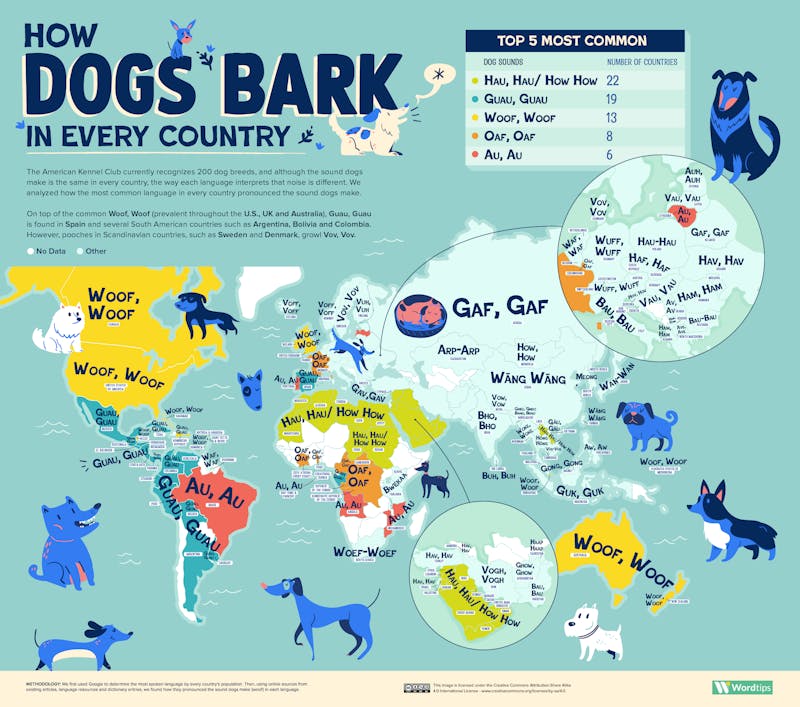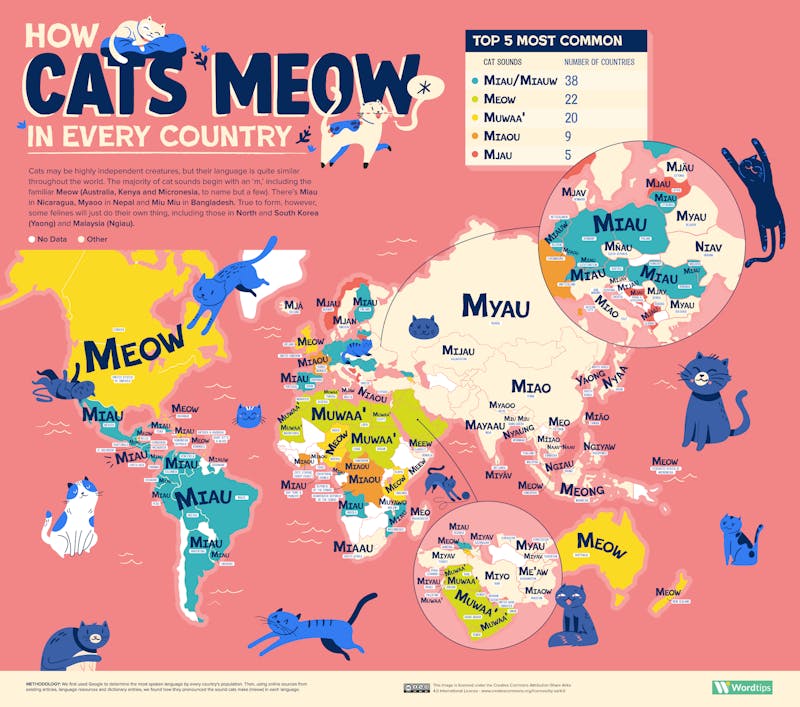How Dogs Bark and Cats Meow in Every Country
Last update: 4/20/2023

Let’s face it — everyone has wished they could talk to animals at some point. And while some communication does exist with our furry friends — they can listen to commands, we can decipher their noises and some can even use sign language — sadly, unless you’re Dr. Dolittle, it’s impossible to really talk to an animal.
Instead, humans can only interpret what animals are saying as best they can. And even though animals of the same species will generally make the same noises wherever they are on the planet, it turns out that how we convert them into human sounds often differs by language and country.
For example, if English is your first language, you’ll know that Old MacDonald’s famously noisy farm is full of pigs that oink. But did you know that pigs boo boo in Japan and nöff-nöff in Sweden? Meanwhile, a mouse will squeak to English speakers, but to a Dutch ear, mice will adorably piep; these are all onomatopoeia examples.
But when it comes to the creatures we want to understand the most, it’s likely those very special animals that 88% of Americans consider a part of the family — our pets. With this in mind, our animal-loving analysts at WordTips wanted to find out how dogs and cats — the world’s two most popular pets — sound around the world. Read on to explore our findings.
What We Did
We began by finding out what the most spoken language is in 147 countries worldwide. We then trawled the internet for reliable articles and dictionary entries to find out how the sounds dogs and cats make are pronounced in each language.
Key Findings
- Around the world, there are at least 40 interpretations of a dog’s bark.
- In 13 English-language countries, dogs are known to woof, woof.
- Meanwhile, dogs make a hau, hau or how, how noise in 22 countries.
- In most countries, cats make a noise beginning with ‘m’ (e.g., meow).
Dogs Hau, Hau in More Countries Than They Woof
Woof, woof is the standard interpretation of a dog’s bark in 13 English-speaking countries, including the U.S., Canada and several Caribbean nations. However, in 19 Spanish-speaking countries, the noise a dog makes is written as guau, guau, and the standard in 22 mostly Arabic-speaking countries is hau, hau or how, how.
The list doesn’t stop there; however — we counted over 40 different phrases around the world for the same noise, among them bho, bho in India, ave, ave in Macedonia and oaf, oaf in France.
These interpretations vary so much because they’re largely onomatopoeic (meaning they are written exactly how they sound), and how they are written partly depends on linguistic rules. For example, according to linguist Anthea Fraser Gupta, this explains why a dog makes a woof sound in English-speaking countries but a wāng sound in China — words can’t end in ‘f’ in Mandarin Chinese.
From ruff to bow-wow, language researcher Derek Abbott notes how dog noise interpretations can even vary a lot in English and theorizes that this is because there are so many domesticated dogs in English-speaking countries (the U.S., for instance, counts the world’s biggest dog population). In contrast, his research reveals that only one country (Sweden) has a word for the sound a moose makes (bröl, in case you were wondering).
A Cat’s Meow Is Similar Around the World
Unlike a dog’s bark, cat noises are interpreted fairly consistently across the world. We found that cats meow in 22 countries, including English-speaking countries like the U.S., the UK and Australia, and select non-English-speaking countries like Tanzania and Armenia. Elsewhere, cats are most likely to make a similar onomatopoeic noise beginning with an m, like miau, miaou or muwaa.’
In other countries, someone imitating a cat will make a similar sound beginning with ‘n.’ These countries include Greece (niaou), Malaysia (ngiau) and Japan (nyaa), a sound immortalized in a 2011 meme. In some cultures, it’s theorized that cats were originally named after their characteristic meow — in cat-loving Ancient Egypt, for example, our feline friends were known as ‘miu.’
According to the ASPCA, a cat uses its distinctive meow to communicate. As kittens, cats will meow to their moms if they’re hungry or cold, and adult cats exclusively meow to their human companions for attention or to say hello.
The Case for Talking to Your Pets
We may not share a common language with our furry friends, but talking to them is worthwhile all the same. When it comes to dogs, it’s especially useful to use ‘dog-speak,’ that high-pitched baby-talk voice we’re all guilty of when chatting to a cute pooch. That’s because one study revealed that dogs bond more with people who use that specific tone while talking about fun doggy things like going for a walk. You only have to turn to TikTok to see how effective dog-speak is at engaging with a dog.
If you’re more of a cat person, you’ll know that cats can be pretty aloof when it comes to responding to their human butlers. It’s all for show, though: one study carried out by the University of Tokyo found that cats do, in fact, pay attention to their owner’s voice and feel safer when a softer tone is used. According to feline behaviorist Marilyn Krieger, cats can even learn their names and are capable of being trained to come when called.
Lastly, don’t feel silly for talking to your pets — it might just mean you’re very intelligent. Behavioral science professor Dr. Nicholas Epley theorizes that anthropomorphizing pets (which means giving them human qualities, for instance, chatting as if they’re human) reflects our ability to recognize other people’s consciousness.
Methodology & Sources
We began by determining the most spoken language in each country. In some cases, this meant we ignored the official language of the country, which often was only used by government bodies or for written purposes.
Then, using reputable online sources from existing articles, language resources and dictionary entries, we found how they pronounced the sounds cats and dogs make (woof and meow) in each language.
We noted down the alphabetic versions of each word rather than their corresponding symbols, such as Chinese characters.
The data was collected in October 2022.
We hope this article has tickled your onomatopoetic and pronunciation taste buds! If you want to learn more about onomatopoeia or get some paperless practice pages for elementary kids, head to our onomatopoeia worksheets, where we've got flashcards, more onomatopoeia words, and quizzes.

